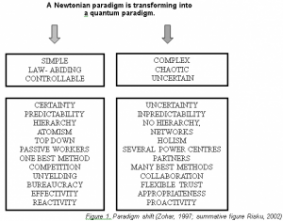The central scope in this chapter is that of organisations and people in organisations in a changing world. It examines collaborative teacher learning from the perspective of organisations, based on the related definition in the previous chapter (What is Collaborative Teacher Learning?).
This brief summary is an extract from the EFFeCT paper, titled Why Collaborative Teacher Learning is Important? that was written by the Finnish partners, Mika Risku and Matti Pennanen (Institute of Educational Leadership, University of Jyväskylä). The essential message is that the world is changing in ways that increasingly demand individual learning to connect with organisational learning for organisations, and with their members, to meet the demands of the changes.
Collaborative teacher learning from the perspective of organisations
Our definition of collaborative teacher learning states that teachers’ learning takes place in their socio-cultural contexts. These socio-cultural contexts include teachers’ professional operational environments: classrooms, schools, local provisions of education and national education systems. They are in turn located in local communities, school districts and/or municipalities, regions and nations. These, however, also involve private and public organisations representing all fields of society. Furthermore, the entire above increasingly interconnects in various trans-national settings that have a share in the redefining of local, national and multi-national organisations’ missions, visions and strategies in terms of whether the organisations represent education or other fields of society.
Zohar (1997) claims that our world is experiencing such a fundamen tal change that we can talk about a paradigm shift. In this shift, our basic mindset is challenged to radically renew itself to meet the demands that the changes in our socio-cultural context impose on us. (Read more about these changes in the original study).
tal change that we can talk about a paradigm shift. In this shift, our basic mindset is challenged to radically renew itself to meet the demands that the changes in our socio-cultural context impose on us. (Read more about these changes in the original study).
(…)
The complex world of the quantum paradigm
The complex world of the quantum paradigm with its many power-centres and networks ranging from local to transnational levels, emphasises the notion of the context as a socio-cultural entity, as we have described it in our definition for collaborative teacher learning. In the quantum paradigm, organisations and their members work together in constantly evolving arrangements. Thanks to modern online platforms, organisations increasingly connect with each other in everyday virtual face-to-face ‘meetings’, wherever they are in our sphere of operation and whatever socio-cultural contexts they have. (…)
The changes shown here demand that we learn how to develop ourselves and our actions in an operational environment that is in several ways the opposite of what we have been used to. The challenge is intensified by the fact that as we try to learn how to manage in the new operational environment, its structures, processes and practices are still often those of the old ways. As a result, we have to develop while we try to learn. Due to the nature of the new operational environment, our solitary learning is no longer sufficient; learning has to be collaborative. Even small changes can affect organisations but the ones connected with the paradigm shift are radical and multiply the effects in both quantity and quality. (…)
Individuals’ self-activity
Furthermore, our definition of collaborative teacher learning includes individuals’ self-activity to interact in purposeful processes that aim to provide supportive teachers’ learning based on participative and inclusive values and dedication. This resonates well with the demands of the quantum paradigm for proactivity, collaboration and partnership.
According to the resource-agency duality model of distributed leadership, individuals’ self-activity is needed if we wish to establish resources for organisations. On the other hand, self-activity allows individuals to influence their organisations and their members. This in turn creates complex power relations amongst the members, who conceive their organisations in their own individual ways. (Tian, Collin & Risku, 2016). To avoid harmful power conflicts, it is necessary to base collaborative teacher learning and teachers’ self-activity on participative and inclusive values and dedication, as our definition of collaborative teacher learning states. This includes renewing missions, visions and strategies collaboratively to guide and develop educational institutions to meet the demands of the changing operational environment.
The whole study is available in the EFFeCT paper, in which a deeper description of the quantum paradigm model can be found as well as the consequent necessity of converting the existing education systems. The demands of the new operational environment prompt all organisations to reform their structures, processes and practices in a way that no individual can manage in isolation. Our Finnish partner also introduced the changes in the Finnish legislation towards forming appropriate adult education, which in its various forms must have a stronger role than ever to support individual professionals and their organisations to evolve into professional communities of collaborative learning.
